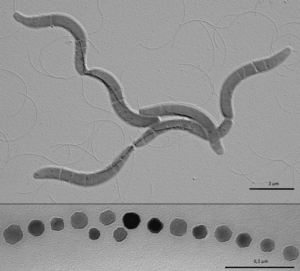Magnetotactic Bacteria
Introduction

Magnetospirillum gryphiswaldense (also referred to as MSR-1) is a gram negative magnetotactic bacteria that is found in shallow fresh water and sediment. They are characterized by a spirillial morphology with flagella at each end of the cell. They are able to orient themselves based on Earth’s magnetic field (magnetotaxis) due to special organelles called magnetosomes.
Other examples:
Bold
Italic
Subscript: H2O
Superscript: Fe3+
Section 1
Include some current research in each topic, with at least one figure showing data.
Section 2
Include some current research in each topic, with at least one figure showing data.
Section 3
Include some current research in each topic, with at least one figure showing data.
Conclusion
Overall paper length should be 3,000 words, with at least 3 figures.
References
Edited by student of Joan Slonczewski for BIOL 238 Microbiology, 2009, Kenyon College.
